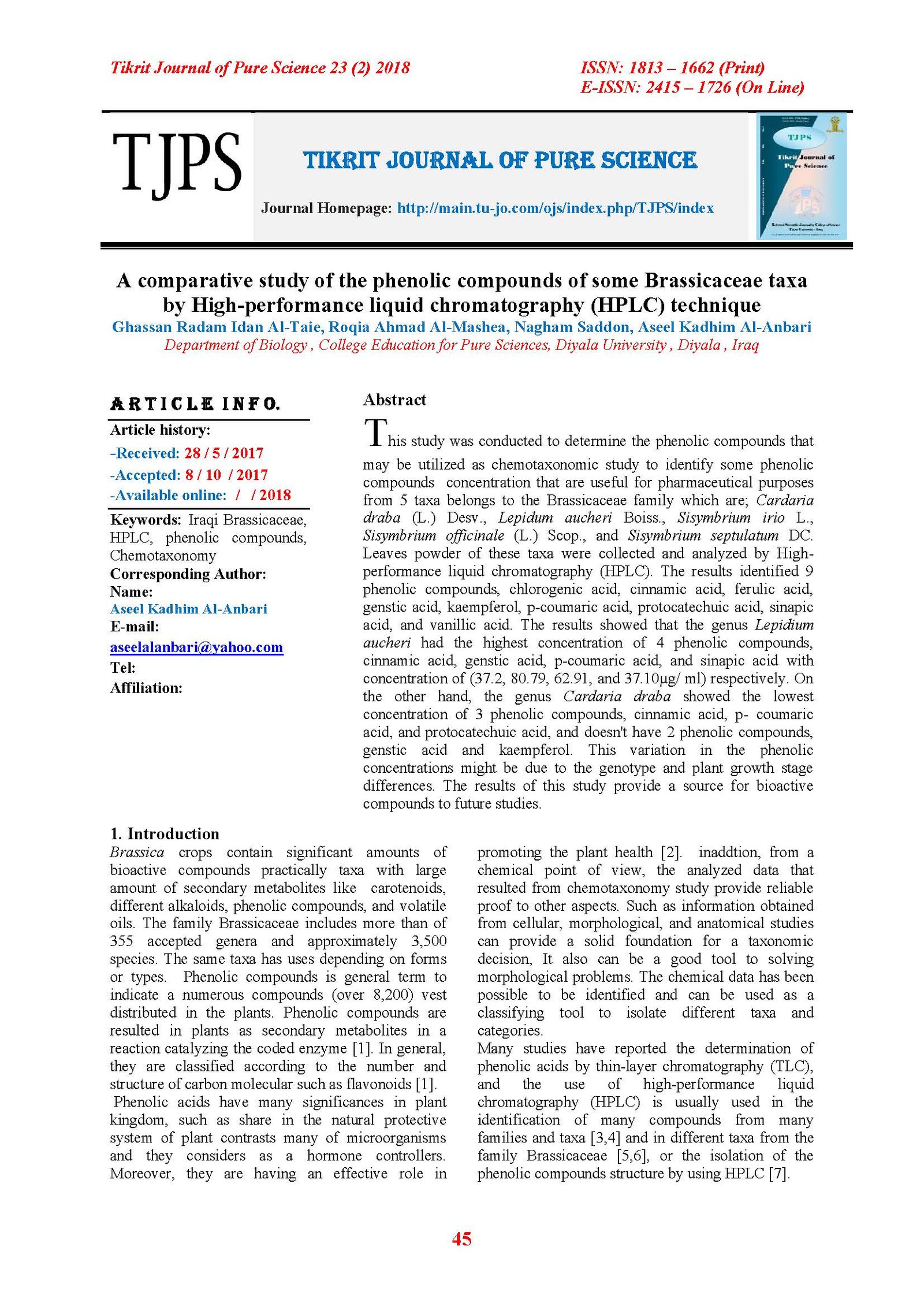A comparative study of the phenolic compounds of some Brassicaceae taxa by High-performance liquid chromatography (HPLC) technique
Main Article Content
Abstract
This study was conducted to determine the phenolic compounds that may be utilized as chemotaxonomic study to identify some phenolic compounds concentration that are useful for pharmaceutical purposes from 5 taxa belongs to the Brassicaceae family which are; Cardaria draba (L.) Desv., Lepidum aucheri Boiss., Sisymbrium irio L., Sisymbrium officinale (L.) Scop., and Sisymbrium septulatum DC. Leaves powder of these taxa were collected and analyzed by High-performance liquid chromatography (HPLC). The results identified 9 phenolic compounds, chlorogenic acid, cinnamic acid, ferulic acid, genstic acid, kaempferol, p-coumaric acid, protocatechuic acid, sinapic acid, and vanillic acid. The results showed that the genus Lepidium aucheri had the highest concentration of 4 phenolic compounds, cinnamic acid, genstic acid, p-coumaric acid, and sinapic acid with concentration of (37.2, 80.79, 62.91, and 37.10µg/ ml) respectively. On the other hand, the genus Cardaria draba showed the lowest concentration of 3 phenolic compounds, cinnamic acid, p- coumaric acid, and protocatechuic acid, and doesn't have 2 phenolic compounds, genstic acid and kaempferol. This variation in the phenolic concentrations might be due to the genotype and plant growth stage differences. The results of this study provide a source for bioactive compounds to future studies.
Article Details

This work is licensed under a Creative Commons Attribution 4.0 International License.
Tikrit Journal of Pure Science is licensed under the Creative Commons Attribution 4.0 International License, which allows users to copy, create extracts, abstracts, and new works from the article, alter and revise the article, and make commercial use of the article (including reuse and/or resale of the article by commercial entities), provided the user gives appropriate credit (with a link to the formal publication through the relevant DOI), provides a link to the license, indicates if changes were made, and the licensor is not represented as endorsing the use made of the work. The authors hold the copyright for their published work on the Tikrit J. Pure Sci. website, while Tikrit J. Pure Sci. is responsible for appreciate citation of their work, which is released under CC-BY-4.0, enabling the unrestricted use, distribution, and reproduction of an article in any medium, provided that the original work is properly cited.
References
[1] Crozier, A.; I. Jaganath,; M. Clifford. 2006. Phenols, polyphenols and tannins: An overview. In Plant Secondary Metabolites: Occurrence, Structure and Role in the Human Diet; Crozier, A.,
Clifford, M., Ashihara, H., Eds.; Blackwell: Oxford, UK, 1-24.
[2] Crozier, A.; I.Jaganath ; N. Clifford. 2009. Dietary phenolic: Chemistry, bioavailability and
effects on health. Nat. Prod. Rep., 26:1001-1043.
[3] Fadi,O.; R. Abdulkader, A. Samir, and C. Eyad, 2012.The cytotoxic effect of essential oils C. aurantium peels on human colorectal carcinoma cell line (LIMI1863).” JMBFS, 1(6):1476-1487.
[4] Al- Anbari A., T. Alkhesraji, A. Al-Mashhadani, and H. Aljewari, 2013, “Determination of some chemical compounds in Citrus species in Iraq.” International Journal of Advanced Research, 1( 7): 555-562
[5] Vallejo, F.; F. Tomas - Barberan,; F. Ferreres, 2004,Characterisation of flavonols in broccoli (Brassica oleracea L. var. italica) by lC-UV diode-array detection-electrospray ionisation mass spectrometry. J. Chromatogr. 1054: 181-193.
[6] Olsen, H.; Aaby, K.; G. Borge. 2009, Characterization and Quantification of Flavonoids and
Hydroxycinnamic Acids in Curly Kale (Brassica oleracea L. convar. acephala var. sabellica) by HPLC- DAD-ESI-MSn. J. Agric. Food Chem. 57: 2816-2825.
[7] Khattab, R.; Eskin, M.; Aliani, M.; Thiyam, U. 2010,Determination of Sinapic Acid Derivatives in Canola Extracts Using HPLC. J. Am. Oil Chem. Soc.
87: 147-155
[8] Al- Farsi, M. and Y. Chan, 2008, “Optimization of phenolic and dietary fiber extraction from date seeds. Food chemistry, 108: 977- 985.
[9] Fernandes, F.; P.Valentao; C. Sousa; J.Pereira; R. Seabra; P. Andrade. 2007.Chemical and antioxidative assessment of dietary turnip (Brassica rapa var. rapa L.). Food Chem., 105:1003-1010
[10] Francisco, M.; D.Moreno; M.Cartea; F. Ferreres,; C. Viguera; P.Velasco. 2009. Simultaneous identification of glucosinolates and phenolic compounds in a representative
collection of vegetable Brassica rapa. J. Chromatogr, 1216: 6611-6619.
[11] Yasir, M. B. Sultana, and M. Amicucci, 2016, “Biological activities of phenolic compounds extracted from Amaranthaceae plants and their LC/ESI-MS/MS profiling. Journal of Functional food, 26: 645-656.
[12] Cartea, M. E, M. Francisco, P. Soengas and P. Velasco. 2011, Phenolic Compounds in Brassica Vegetables. Molecules, 16: 251-280
